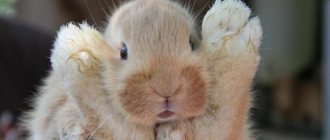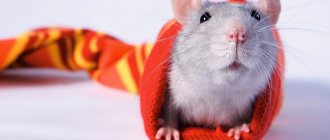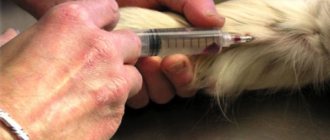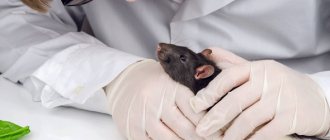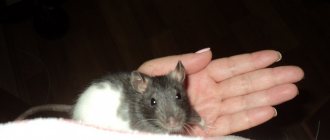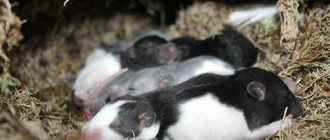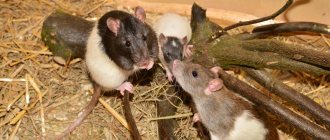It is not necessary to trim your rats' claws, and you can try other methods to shorten your animal's claws. Trimming rat nails can be stressful and difficult. Because rats are small and difficult to keep in place, it can be quite difficult to carry out the procedure correctly. In this article, we will try to answer basic questions about trimming rats' claws.
Rat care
Rat bathing
There is no need to bathe/wash rats (moreover, it is harmful for rats!), but despite this, often rat owners by washing the rat want to get rid of what they consider to be unaesthetic aspects such as an unpleasant odor emanating from the animal, browning of fur, porphyrin stains on the face or back, scratching, dandruff, matted or dirty fur.
Remember: you won’t get rid of anything on this list by bathing your rat!
- The cause of the smell is most often inappropriate living conditions (the cage is too small, the cage is rarely cleaned and hammocks/filling are changed) or health problems (in this case, I advise you to contact the recommended veterinarian or at least the veterinary section on the forum), i.e. Washing won't help matters. Moreover: you will remove all odors and sebum from the rat over and over again, the rat’s body will compensate for this over and over again by increasing the smell and secreting even more sebum. The smell from the rat will become much greater.
- Browning fur is not a sign of contamination! The cause of browning is most often the genetics of the rat (for example, the presence of lightening genes), age-related changes, and occasionally browning and, in general, a local change in the color of the coat appears at the sites of injections or contact with other substances.
- Of course, you can wash off porphyrin stains, but this will not help, because it will appear again. We need to find out the reason for its appearance. The appearance of porphyrin is a reason to consult a veterinarian!
- Matted fur is one of the signs of health problems and a reason to consult a veterinarian. Washing in such a situation will not help, but may worsen the situation.
- Scratching is a symptom of a rat having parasites (subcutaneous or cutaneous) or allergies. There is no need to wash your rat with various pet shampoos that promise relief! The rat needs to be treated for both parasites and allergies, and not washed with “miracle” shampoos.
- Dandruff is normal for males after one and a half years. There is no need to wash it; after washing, even more dandruff will appear. Just accept its presence.
- The rat will clean off dirt on its fur (soil, dust, liquid food) perfectly on its own.
Article on the topic: Hammocks for rats: purchased and made with your own hands (photo ideas)
Possible consequences of bathing:
- Rats are prone to respiratory infections, i.e. trite - they catch cold easily. And if in humans a cold most often goes away on its own, then in rats such respiratory diseases often end sadly: either chronic rhinitis or pneumonia, which is fatal. Is your “bath procedure” worth your pet’s long-term antibiotic treatment?
- Water getting into rat ears leads to otitis media. Otitis is often asymptomatic and sometimes the owner notices that something is wrong when it is already too late. But even if otitis is noticeable and you react quickly enough, keep in mind that otitis in rats is very difficult to treat, long, difficult and causes great suffering to the animal.
- In addition, washing violates the natural protection of the skin and coat. If for some reason the body cannot compensate for the lost protection by producing more sebum, then the skin becomes dry and sensitive, it may begin to itch, and the hair will become thin and brittle, “husked.”
- Washing is always stressful for a rat, which leads to a weakening of the immune system and in itself “opens the door” to various diseases, infections, neuroses, etc.
If washing cannot be avoided , for example, the rat got dirty in a harmful substance or you want to prepare your pet for an exhibition, then everything is quite simple:
- You will need: two towels, two bathtubs/basins and rodent shampoo or just mild baby shampoo.
- Have 2 towels at an accessible distance. Pour warm water into both baths, about 5 centimeters. Place a rat in one of them. Gently wet the rat's fur, avoiding getting any water on the rat's face.
- Apply a small amount of shampoo to the coat and massage it gently into the coat. No need to create a lot of foam! Avoid getting foam into the animal's ears and eyes.
- Rinse the shampoo out of the fur by scooping up the water with your hand.
- Transfer the rat to another bath. Carefully rinse any remaining shampoo from the coat with clean water; it should not remain on the coat/skin!
- Use a towel to wipe the surface of the rat's fur, this will help get rid of excess water. Wrap the rat in a second dry towel. Keep it wrapped up until it is at least partially dry. After this, it makes sense to let the rat out for a walk under a blanket or blanket - this will reduce the risk of catching a cold.
Article on the topic: How to stop a pet rat from biting: instructions
If the substance that gets on the rat’s fur is very dangerous and delay can cause harm to the animal, then simply turn on warm water and rinse the rat’s fur directly under running water. Then dry the rat's fur and be sure to show your pet to the veterinarian!
Author VaKa
I thank Elena Snezhurova aka Malyavka for her help in writing the article.
Grooming
The rat takes care of its fur itself. And if she lives in a group, which is desirable, then her “flockmates” also help her do this - this is called mutual grooming and serves to strengthen social ties between representatives of the same flock. If the rat is healthy and takes care of itself, then there is no need to help it with grooming; it can handle it on its own. Problems usually arise in weakened, old animals that find it difficult to reach, for example, the back) and in this case they will need your help.
Grooming your rat's fur with the least amount of stress and intervention has two parts:
- Comb the fur . Scratching improves blood circulation in the skin and removes dead particles from it. A new, unused toothbrush with soft bristles is best for this. It’s most convenient to remove the long handle (since rats don’t really like a strange tool with a long handle and they often attack a “full-fledged” toothbrush) and scratch the rat, holding the head of the toothbrush with your thumb and forefinger (i.e., as if hiding it between the fingers). During the procedure, a calm tame rat can be placed on your lap, and independent rats can be scratched when they are sleeping or busy with a treat, then this procedure will not cause them stress and will be calm.
- We clean the wool . There is no need to wash the rat and risk its health for this! It is enough to wet a cotton pad and gently wipe the animal’s fur with the damp pad. After the procedure, the rat must be wiped dry.
Article on the topic: DIY toys and entertainment for rats - photo ideas
Author VaKa
Ear care
Rat ears do not require any special care, because... healthy and young rats can clean their ears quite well on their own. Therefore, you don’t need to clean your ears just like that with cotton swabs or other devices - they can easily injure the delicate skin, which can be very painful for the rat, and there is simply no point in using special ear care drops in this case.
Special care for the ears is required only when the rat has become old, weak and can no longer cope with this procedure on its own. Only then does it make sense to instill special drops, and after that, carefully clean with cotton swabs, but do not clean deeply.
Please note that “dirt” in the ears and/or an unpleasant odor are not signs of dirty ears, but a reason to go to the veterinarian and treat the rat, because, most likely, it has otitis media.
Author VaKa
Nail trimming
Trimming rats' claws is a cosmetic procedure that is usually not a mandatory part of rat care. However, there are a number of situations in which the rat will still need to perform it.
When does a rat need to have its nails trimmed?
- Most rats keep their claws in order by not allowing them to grow too long. However, it happens that in sedentary, sick, old or simply too lazy animals, the claws outgrow the normal size so much that they bend, threatening to stick into the pad of the finger, and, in addition, cling to hammocks and other textile equipment of the cage and walk. This can lead to the rat getting caught and tearing out a claw or dislocating a paw. Of course, this cannot be allowed.
- After operations, as well as in the presence of wounds or scratches, rats have their claws trimmed to prevent sharp claws from injuring the wound or unraveling the stitches.
- In addition, rats' claws are trimmed for aesthetic purposes - for example, before exhibitions, or so that sharp claws do not leave scratches on the arms and shoulders of their owners. You can also “demilitarize” the flock before adding newcomers, in order to deprive them of additional “weapons” in the event of a showdown, and to avoid scratched skin of the new one.
Article on the topic: How to make a rat cage with your own hands from scrap materials at home
It is convenient to trim claws with the following tools:
- A special nail clipper for cats of the smallest size. According to rat breeders, this is the most convenient.
- Regular nail clippers or nail clippers. Nail scissors are inconvenient to use for this purpose, because... with their help, the claw is cut and not bitten off, which complicates the procedure - the scissors will simply slide off. The tools, of course, should be as sharp as possible so as not to delay the process and not split the claw.
The vast majority of rats will not like this idea. Therefore, if the pet does not want to sit quietly, breaks out and takes away its paws, it is more advisable to carry out the haircut together - the assistant will hold the rat while the owner deals with the overgrown claws. The haircut process itself is simple, but requires care and precision, because... The rat's claws and fingers are very small. You need to fix the paw with one hand, and with the other, cut off the very tip - the transparent part of the claw. You can’t cut further - the living part of the claw begins, with blood vessels and nerves. If you overdid it and started bleeding, keep hydrogen peroxide on hand. After trimming, if the cut is crooked, very sharp or split, the claw can be processed with a nail file.
Author Zatrian
Tail cleaning
The tail is a very important and undoubtedly wonderful part of every rat. However, for the most part, the rats themselves do not think about this, and therefore do not particularly monitor its appearance. Little rats have pink, clean tails, but the older the animal, the dirtier its tail tends to be. Some rats do clean their tails themselves, but this is the exception rather than the rule. A dirty tail does not cause any inconvenience to the rat, unlike its owner, hurting his sense of beauty. In addition, at a rat show, points are deducted from an animal for having a dirty tail.
Article on the topic: Names for rats, girls and boys: how to name a rodent (help in choosing a nickname)
In general, there are only two good reasons to give your rat a tail cleaning:
- Upcoming exhibition. The tail is cleaned to avoid underestimation.
- Hot weather. The main heat exchange in rats occurs through the tail. If it is completely covered with dirt, heat exchange will be difficult, which in some cases can even lead to overheating of the body.
How to do it right:
- For washing you will need a soft toothbrush, baby soap and warm (not hot) water.
- First, you need to “soak” the tail in soapy water. If the rat takes this calmly, you can simply immerse the tail in a container of water; if not, you should slowly soak it by wiping it with a soapy, wet cotton pad.
- After you have achieved the desired result in one way or another, you need to take a toothbrush and carefully, without strong pressure, brush your tail from the base to the tip, i.e. in the direction of scale growth, in no case against it! Do not rub the tail with force - you can damage and tear off the scales. When cleaning, do not hold the rat by the tip of its tail! Just a little effort is enough for the skin to simply peel off like a stocking from a leg. In this case, you will have to run to the veterinary clinic, and not to the exhibition.
- The cleaned tail is thoroughly rinsed with clean water and dried with a towel. After washing, you can lubricate it with baby cream, because... soap dries out the skin.
- If the rat's tail is very dirty, do not try to wash it at once - it won't work anyway, you will only injure it if you try too hard when cleaning. Just repeat the procedure every other day or two, and gradually the tail will wash off.
It is worth remembering that the degree of contamination of the tail is closely related to the conditions of detention. In a small, neglected cage that is rarely cleaned, rats' tails get dirty much faster.
Article on the topic: Harness and leash for rats: application, purpose, manufacture
Trimming process
For a haircut you need to stock up on:
- manicure scissors,
- nail clippers (nail clippers)
- or a special nail clipper for small animals.
For the first time, it is better to do the procedure with an assistant. The rat will spin around, so it is more convenient for one person to hold it, and the second to trim its claws.
The rat's claw consists of two parts:
- wide at the base (blood vessels pass through there - they should never be damaged)
- narrow, turning into a needle-shaped tip. This tip needs to be cut off.
Rat claws are translucent, they are almost transparent, so the place where the vessels are located is visible to the naked eye.
The assistant holds the rat tightly, and the person trimming the claws takes its paw and, sticking out his fingers one by one, cuts off the sharp ends of the claws. Rats' paws are fragile; they must be handled with care during grooming. In total, the rat has 18 claws - four on the front legs and five on the hind legs.
If it seems that the rat's trimmed claws could be made even shorter, the length should be adjusted with a nail file. This way the vessels will definitely not be damaged. If blood comes from the claw, there is no need to panic. You just need to blot the wound with a piece of cotton wool soaked in hydrogen peroxide (chlorhexidine will also work) and hold it tightly against the wound until the bleeding stops. If the bleeding does not stop, you can dip your claw in dry manganese powder.
Subsequently, knowing how to trim a rat’s claws correctly and having gained experience, you will be able to carry out the procedure without an assistant - alone. After trimming the pet’s claws, you should treat it with a treat so that it doesn’t get offended. The first time after clipping, the animal, while climbing, may slide off surfaces - this is normal, it will soon adapt to the absence of claws and become dexterous again.
Is it possible to trim a rat's claws and how to do it safely?
The rat is considered one of the smartest animals. This decorative rodent is small in size. It is easily tamed and does not require special conditions.
Caring for a rat is easy. The animal does not need to be specially bathed or combed. He can take care of himself. However, owners reasonably wonder whether it is necessary to trim a rat’s claws. Indeed, a rodent cannot take care of them on its own.
Our advantages
How to trim a rat's claws Rostov-on-Don - we have the solution.
That's why they choose us to bake.
Pet taxi
We will help your friend at home, or transport him to the clinic, using our own zoo-taxi
Seven days a week
Our only day off is January 1st. You can contact us any day, we work around the clock, without days off or breaks.
New technologies
The clinic’s equipment makes it possible to perform operations that are inaccessible to other veterinary hospitals in the city.
Good plus
You can purchase medicines and food for your animal directly from our clinic.
Let's be professional
Our doctors are professionals with extensive experience and a responsible approach to their work.
Let's improve
We are members of the Union of Pet Business Enterprises of Russia, initiators of programs for the development of progressive veterinary medicine and animal care.
Do rats have their claws trimmed?
If you think about it, the positive answer to this question is obvious. Animals' claws grow continuously. But in nature they are constantly worn down, coming into contact with stones, sand, dense soil, roots and branches of trees.
The owners take their dogs for walks. Running on asphalt and digging in the ground helps to partially wear down the claws. For cats, a caring owner specially places a wooden board. In this way, he saves carpets and sofas from his pet’s habit of sharpening its claws on everything that comes along.
A rat living at home does not have the ability to naturally regulate the length of its claws. As they grow, they bend inward and injure the pads. Curled nails make it difficult to position your paws correctly. This leads to curvature of the fingers and makes it difficult for the animal to move.
The rodent actively uses its claws: it holds food with them while eating, with their help it climbs and climbs on various surfaces, and defends itself.
At the same time, the animal inadvertently scratches its owners and makes puffs on clothes and furniture upholstery. It happens that an animal pulls out a nail that is too long, getting caught in the fibers of a carpet or bedspread. This is a rather painful and dangerous injury. It’s even worse if a child gets injured while playing with a rat.
Trimmed claws are an indispensable condition for participation in exhibitions. This is another argument in favor of cutting them.
Article on the topic: Water bowl, clothes, carrier and ball for a rat - do rodents need such accessories?
High-quality treatment from specialists
We offer our visitors the highest level of modern diagnostic equipment. How to trim a rat's claws Rostov-on-Don - we have the best treatment. Patients in intensive care and hospital are under constant medical supervision. The veterinary pharmacy, located in the lobby of the clinic, sells all the necessary medications to treat your pets. Here you will find EVERYTHING without long searches and with a guarantee of high quality! If necessary, you can order delivery of medicines, food and pet accessories to your home. To transport your pet, use our pet taxi, which will take you and your pet to the veterinary clinic from anywhere in Rostov-on-Don and the region. Call us, we will be happy to answer all your questions. By asking us a question you can get a free consultation with a doctor. Rest assured, by visiting the website of our veterinary clinic, you will always be able to find an up-to-date answer to your question, be it a description of a procedure or a description of rare diseases of dogs and cats. Our veterinary clinic conducts active educational work. On our website you can read articles devoted to various aspects of the treatment and care of animals, as well as a modern view of veterinary medicine.
How to trim a rat's claws
The clipping procedure can be stressful for your rat, so you need to be well prepared for it. First of all, you need to imagine how the animal’s claw works. His paw is very small, the transparent claws are not hidden in the pads and are clearly visible:
- the claw begins with a wide part (pulp) - a sensitive area of pale pink color. Blood vessels are clearly visible in it;
- The nail ends with a thin horny process.
You need to trim the very tip without touching the pulp. It is better to use the help of someone in your household if your rat is very active or you are doing the procedure for the first time. Your assistant will carefully but securely secure the rodent, and you will calmly trim the claws. There are 18 of them - five on the front legs and four on the hind legs.
Nail scissors, like the ones we use to cut our own nails, are not suitable for rats. The human nail and the animal claw differ in shape. Scissors can jam the claw and damage the pulp.
For cutting, you need to purchase special nail clippers. Knipsers - small nail clippers - are also convenient. They are safe; they can be used to cut the nails of even newborn children.
The haircut procedure is performed as follows:
- Taking the paw in your hand, press lightly on it to spread your fingers. Make all movements extremely carefully, because your pet’s paws are small and fragile;
- trim the very tip of the nail. Be careful not to touch a blood vessel;
- If you feel that the claw is too long after trimming, do not try to shorten it with pliers. Here you can make a mistake and cut off the excess, touching the pulp and causing bleeding. Use a regular nail file and carefully trim the claw to the desired length;
- If you accidentally injured the pulp until it bleeds, moisten a cotton swab with hydrogen peroxide, chlorhexidine or any antiseptic and press firmly to the wound until the bleeding stops. If there is heavy blood flow, dip the claw in potassium permanganate powder.
Article on the topic: Hammocks for rats: purchased and made with your own hands (photos of ideas)
After the procedure, your pet will sometimes slip off inclined surfaces for some time. Don't worry, he will adapt very soon. If you accustom a rat to clipping from an early age, it will begin to tolerate this operation calmly, and you will be able to trim its claws without an assistant.
What is needed for shortening
The first and most important thing you need is a tool. It can be a special cutter for small animals (also called a “claw cutter”), a nail clipper, or, in extreme cases, wire cutters. It is also necessary to have a treat on hand - if the rodent becomes very nervous, you can treat it and the resistance on its part will decrease. A file is a desirable attribute that will help remove remaining length and blunt sharp or irregular cuts.
Important! Nail scissors should not be used for trimming
—
they do not cut “in one fell swoop”, they can slip off, and dull blades cause discomfort and even pain to the animal.
The role of claws in the life of a rat
This rodent needs claws for a full-fledged existence. With their help, the rat climbs, climbs vertical surfaces, and protects itself from enemies. But when the claws grow too long, they begin to get in the way. The animal cannot place its paws comfortably: the toes become bent, the rat begins to move differently from the way it is intended by nature. And if your pet also runs on soft surfaces (for example, on a carpet or sofa), it can catch its claw on the fabric or lint and tear it off.
Overgrown long claws cause inconvenience not only to the rat itself, but also to its owner in the form of constant scratches on the hands. Problems also arise if the rat is a show rat. More than a dozen rats pass through the hands of experts from the jury, so one of the conditions for competition participants is trimmed claws.
We serve all areas
We serve all areas of the city of Rostov-on-Don. We go to the house.
- How to trim a rat's claws 1st Street
- How to cut a rat's claws Sverdlovskaya street
- How to trim a rat's claws Varfolomeeva Street
- How to trim a rat's claws Izobilnaya Street
- How to trim a rat's claws Lawn 3rd Lane
- How to trim a rat's claws Raskatny 10th Lane
- How to trim a rat's claws Milyutinsky Lane
- How to trim a rat's claws Tsushima Lane
- How to trim a rat's claws on Komitetskiy Lane
- How to trim a rat's claws Stolyarny Lane
- How to cut a rat's claws Ivakhnenko street
- How to trim a rat's claws Loud Lane
- How to trim a rat's claws Station Square
- How to trim a rat's claws Sputnikovy 1st Lane
- How to trim a rat's claws Glubokoy Lane
- How to trim a rat's claws Yasnaya Ulitsa
- How to trim a rat's claws Onezhskaya Street
- How to trim a rat's claws on Krasnykh Partizan Lane
- How to cut a rat's claws Peskova street
- How to trim a rat's claws Mozdoksky Lane
